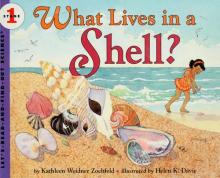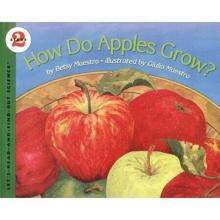No name
Animals in Winter
A beautifully illustrated look at where various animals go when it snows and how they prepare for winter. We learn details of the migration of various animals (such as birds, butterflies and bats), animals that hibernate, animals that store up food for the winter and animals that have to find their food throughout the winter. Includes instructions for feeding birds and other wild animals in your own backyard.
How a Seed Grows
A very simple, charming book that explains to young children what seeds are and takes them through the development of some bean seeds. The growth present each day is illustrated in the book and the child is invited to try grow the beans themselves and watch the progress in real life. The book also introduces children to different kinds of seeds (for trees, flowers, vegetables, etc.), and how each seed will grow into the same kind of plant that it came from, and the basic things necessary to make a plant grow.
What Lives in a Shell?
This beautifully illustrated book, designed for preschool and kindergarten, explains different kinds of shells and the creatures that inhabit them. The shells are compared to the shelter occupied by people and by other animals. We learn that some shells do grow larger along with certain animals while other animals must shed their out-grown shell in favor of a new one. Many shells are beautifully depicted and identified and the story-format of the text is very easy and interesting for young children to follow.
Falcons Nest on Skyscrapers
This is a very interesting book (with excellent illustrations) that introduces young children to various falcons living in the United States, some of their remarkable abilities and the story of how some scientists were successful in re-introducing the peregrine falcon in the Eastern United States after they nearly became extinct because of an insect spray called DDT which was overused earlier in the twentieth century. The story focuses on Scarlett, a peregrine falcon who was born in captivity, released, and discovered building a nest thirty-three stories up on the ledge of a skyscraper in Baltimore. This location made observation ideal and we learn that she managed to find a wild falcon for a mate and that their offspring have helped significantly in restoring the falcon population.
Flash, Crash, Rumble and Roll
This simple, nicely illustrated (cartoon-like pictures) children's book explains important concepts of science in a very easy-to-understand fashion. The reader is introduced to the way thunderclouds form and where thunder and lightning come from. The scientific content is substantial and very accessible. The story line is rounded out with tips for staying safe during a storm. My children have been fascinated by the details about the inside of a thundercloud, how fast sound and light travel, how you can measure the distance thunder travels and more. This title has been a big favorite with all of my children for a number of years and, rather than being made nervous by the dangers mentioned in the book, a little knowledge seems to be a comforting thing.
How do Apples Grow?
The development of apples is presented, from leaf and flower buds in the winter, thru blossoms in the spring, pollination and the actual growth of the apple. In addition to beautiful scenic pictures of trees in blossom and bees pollinating the trees, there are more technical drawings which illustrate the parts of a flower, show flowers in the different stages of development and show the connections between the original blossom and the ripe apple. The text also introduces some important terminology that will be useful in later science studies (pollen, stamen, pistil, etc.). Overall, a very nice and useful book.
How do Birds Find Their Way?
A nicely illustrated and interesting look at the amazing phenomenon of bird migration, what we know about how migration works and some various theories about details that are still being studied. Includes a chart of how high various birds fly.
Sunshine Makes the Seasons
"Sunshine warms the earth. If the sun stopped shining, the earth would get colder and colder..." It is important for children to consider the importance of the sun in our lives. In Sunshine Makes the Seasons, children are introduced to the sun's role and in particular how the seasons change because of the earth's rotation around the sun and the tilt of the earth.
In a fashion similar to The Moon Seems to Change, an experiment involving an orange stuck into a pencil (again a styrofoam ball and a chopstick or pencil will work just as well) helps to illustrate the various points that are explained. First the child uses a flashlight with the "axis" of the earth pointed straight up and down to show how the seasons would always be the same in that scenario. Then we are shown that by tilting the earth, the length of each day changes throughout the year. We also see how the North and South Pole are special cases where the midwinter can have several weeks of darkness and midsummer can have continuous light. We also see that the seasons change very little at the equator and that the Northern and Southern hemispheres have opposite seasons from each other. Again, this book covers substantial information in a very simple way and will be very useful and straightforward for early science lessons.
What Makes Day and Night?
The clearly written text is combined with simple, colorful pictures to make the concepts of day and night and the rotation of the earth in relation to the sun very understandable for both young children and their parents. : ) Included is a very simple hands-on "experiment" requiring only your child and a desk lamp. Some information about the moon is also covered. Like other books in this series, this book is a great solution for satisfying some of those "why" questions that young children constantly ask.









